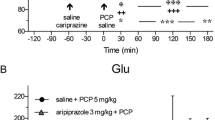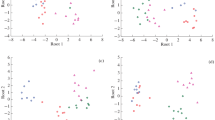Abstract
Noradrenergic mechanisms have been postulated to account for the anticonvulsant and psychotropic effects of carbamazepine. In order to assess this possibility in man, cerebrospinal fluid (CSF) was obtained from affectively ill patients before and during treatment with carbamazepine (average duration 29 days) at doses averaging 860 mg/day, achieving blood levels of 8.86 μg/ml. Neither plasma nor CSF norepinephrine (NE) nor CSF 3-methoxy-4-hydroxyphenylgycol (MHPG) was significantly altered by carbamazepine. Baseline medication-free values in 21 depressed patients were not predictive of the degree of subsequent clinical antidepressant response. CSF NE decreased in four manic patients treated with carbamazepine. The many effects of carbamazepine on noradrenergic mechanisms in animals are discussed in relationship to these first studies of carbamazepine in man.
Similar content being viewed by others
References
Bunney WE Jr, Davis JM (1965) Norepinephrine in depressive reactions. Arch Gen Psychiatry 13:483–494
Bunney WE Jr, Hamburg DA (1963) Methods for reliable longitudinal observation of behavior. Arch Gen Psychiatry 9:280–294
Crunelli V, Cervo L, Samanin R (1981) Evidence for a preferential role of central noradrenergic neurons in electrically induced convulsions and activity of various anticonvulsants in the rat. In: Morselli PL, Lloyd KG, Loscher W, Meldrum B, Reynolds EH (eds) Neurotransmitters, seizures and epilepsy Raven, New York, pp 195–202
DeLorenzo RJ (1983) Calcium-calmodulin protein phosphorylation in neuronal transmission: A molecular approach to neuronal excitability and anticonvulsant drug action. In: Delgado-Escueta AV, Wasterlain CG, Treiman DM, Porter RJ (eds) Status epilepticus. Raven, New York, pp 325–338
Elhwuegi A (1978) Antiepileptic drugs and monoamine metabolism in the brain. Br J Pharmacol 64:407
Ferrendelli JA, Kinscherf DA (1979) Inhibitory effects of anticonvulsant drugs on cyclic nucleotide accumulation in brain. Ann Neurol 5:533–538
Gordon EK, Oliver J, Black K, Kopin IJ (1974) Simultaneous assay by mass fragmentography of vanillyl mandelic acid, homovanillic acid, and 3-methoxy-4-hydroxyphenyl glycol in cerebrospinal fluid and urine. Biochem Med 11:32–40
Jimerson DC, Markey SP, Oliver JA, Kopin IJ (1981) Simultaneous measurement of plasma 3-methoxy-4-hydroxyphenylglycol (MHPG) and 3,4-dihydroxyphenylglycol (DHPG) by gas chromatography-mass spectrometry. Biomed Mass Spectrom 8:256–259
Katz MM, Koslow SH, Maas JW, Secunda SK, Brunswick D, Robins E (1983) Response patterns to tricyclic antidepressants. Abstract, 136th Annual Meeting, Am Psychiatric Assoc, New York, p 75
Lewin E, Bleck V (1977) Cyclic AMP accumulation in cerebral cortical slices: Effect of carbamazepine, phenobarbital, and phenytoin. Epilepsia 18:237–242
Maitre L, Baltzer V, Mondadori C, Olpe HR, Baumann PA, Waldmeier PC (1983) Psychopharmacological and behavioural effects of anti-epileptic drugs in animals. In: Emrich HM (ed) Proc VII World Congress of Psychiatry, in press
Marangos PJ, Post RM, Patel J, Zander K, Parma A, Weiss S (1983) Specific and potent interactions of carbamazepine with brain adenosine receptors. Eur J Pharmacol 93:175–182
Morselli PL, Calderini G, Consolaziones A Riva E, Altamura C (1977) Effect of carbamazepine on brain mediators in control and cobalt-treated rats. In: Meinardi H, Rowan AJ (eds) Advances in epileptology. Swets and Zeitlinger. Amsterdam, pp 176–182
Okuma T (1984) Therapeutic and prophylactic efficacy of carbamazepine in manic depressive psychosis. In: Emrich HM, Okuma T, Muller AA (eds) Anticonvulsants in affective disorders. Excerpta Medica, Amsterdam, pp 76–87
Olpe HR, Jones RSG (1983) The action of anticonvulsant drugs on the firing of locus coeruleus neurons: Selective, activating effect of carbamazepine. Eur J Pharmacol 91:107–110
Palmer GC (1979) Interactions of antiepileptic drugs on adenylate cyclase and phosphodiesterases in rat and mouse cerebrum. Exp Neurol 63:322–335
Phillis JW, Wu PH, Bender AS (1981) Inhibition of adenosine uptake into rat brain synaptosomes by the benzodiazepines. Gen Pharmacol 12:67–70
Post RM, Lake CR, Jimerson DC, Bunney WE Jr, Wood JH, Zeigler MG, Goodwin FK (1978) Cerebrospinal fluid norepinephrine in affective illness. Amer J Psychiat 135:907–917
Post RM, Ballenger JC, Goodwin FK (1980) Cerebrospinal fluid studies of neurotransmitter function in manic and depressive illness. In: Wood JH (ed) Neurobiology of cerebrospinal fluid, vol 1. Plenum, New York, pp 685–717
Post RM, Uhde TW, Ballenger JC, Chatterji DC, Green RF, Bunney WE Jr (1983a) Carbamazepine and its—10,11-epoxide metabolite in plasma and CSF: Relationship to antidepressant response. Arch Gen Psychiatry 40:673–676
Post RM, Uhde TW, Ballenger JC, Squillace KM (1983b) Prophylactic efficacy of carbamazepine in manic-depressive illness. Am J Psychiatry 140:1602–1604
Post RM, Ballenger JC, Uhde TW, Bunney WE Jr (1984a) Efficacy of carbamazepine in manic-depressive illness: implications for underlying mechanisms. In: Post RM, Ballenger JC (eds) Neurobiology of mood disorders. Williams and Wilkins, Baltimore, pp 777–816
Post RM, Uhde TW, Ballenger JC (1984b) Efficacy of carbamazepine in affective disorders: Implications for underlying physiological and biochemical substrates. In: Emrich HM, Okuma T, Muller AA (eds) Anticonvulsants in affective disorders. Excerpta Medica, Amsterdam, pp 93–115
Purdy RE, Julien RM, Fairhurst AS, Terry MD (1977) Effect of carbamazepine on the in vitro uptake and release of norepinephrine in adrenergic nerves of rabbit aorta and in whole brain synaptosomes. Epilepsia 18:251–257
Quattrone A, Samanin R (1977) Decreased anticonvulsant activity of carbamazepine in 6-hydroxydopamine-treated rats. Eur J Pharmacol 41:333–336
Quattrone A, Crunelli V, Samanin R (1978) Seizure susceptibility and anticonvulsant activity of carbamazepine, diphenylhydantoin and phenobarbital in rats with selective depletions of brain monoamines. Neuropharmacology 17:643–647
Quattrone A, Annunziato L, Aguglia K, Preziosi P (1981) Carbamazepine, phenytoin and phenobarbital do not influence brain catecholamine uptake, in vivo, in male rats. Arch Int Pharmacodyn Ther 252:180–185
Ramsay RE, Wilder BJ, Berger JR, Bruni J (1983)_A double-blind study comparing carbamazepine with phenytoin as initial seizure therapy in adults. Neurology 33:904–910
Reus VI, Lake R, Post RM (1980) Effect of piribedil (ET-495) on plasma norepinephine: Relationship to antidepressant response. Commun Psychopharmacol 4:207–213
Scheinin M, Cjang W-H, Kirk K, Linnoila M (1983) Simultaneous determination of 3-methoxy-4-hydroxyphenylglycol, 5-hydroxyindoleacetic acid and homovanillic acid in cerebrospinal fluid with high performance liquid chromatography using electrochemical detection. Anal Biochem 131:246–253
Schildkraut JJ (1965) The catecholamine hypothesis of affective disorders: A review of supporting evidence. Am J Psychiatry 122:509–522
Seppala T, Scheinin M, Capone A, Linnoila M (1984) Liquid chromatographic assay for CSF catecholamines using electrochemical detection. Acta Pharmacol Toxicol 55:81–87
Sillanpää M (1981) Carbamazepine — pharmacology and clinical uses. Acta Neurol Scand [Suppl 88] 64:1–202
Skerritt JH, Davies LP, Johnston GAR (1982) A purinergic component in the anticonvulsant action of carbamazepine? Eur J Pharmacol 82:195–197
Skerritt JH, Davies LP, Johnston GAR (1983) Interactions of the anticonvulsant carbamazepine with adenosine receptors. I. Neurochemical studies. Epilepsia 24:634–642
Sulser F, Janowsky DJ, Okada F, Manier DH, Mobley PL (1983) Regulation of recognition and action function of the norepinephrine (NE) receptor-coupled adenylate system in brain: Implications for the therapy of depression. Neuropharmacology 22:425–431
Ziegler MG, Lake CR, Foppen FH, Shoulson I, Kopin IJ (1976) Norepinephrine in cerebrospinal fluid. Brain Res 108:436–440
Author information
Authors and Affiliations
Rights and permissions
About this article
Cite this article
Post, R.M., Rubinow, D.R., Uhde, T.W. et al. Effects of carbamazepine on noradrenergic mechanisms in affectively ill patients. Psychopharmacology 87, 59–63 (1985). https://doi.org/10.1007/BF00431779
Received:
Accepted:
Issue Date:
DOI: https://doi.org/10.1007/BF00431779




